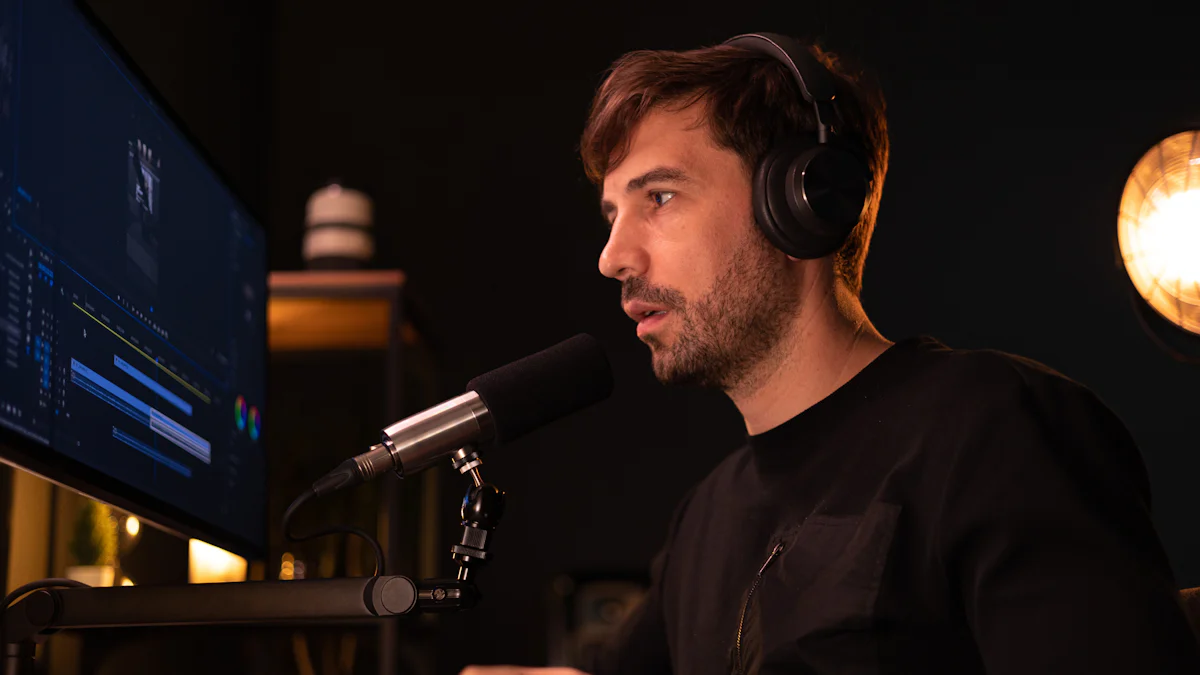How Headsets Use Noise-Cancelling for Clearer Calls

Noise-cancelling technology transforms your call experience by enhancing voice clarity. It reduces background noise, allowing you to focus on the conversation. Whether you're in a bustling office or a noisy home environment, clear calls are crucial. A noise-cancelling mic for headsets designed for office and home calls ensures you communicate effectively. This technology helps you maintain professionalism and efficiency, even in less-than-ideal settings. By minimizing distractions, it allows you to engage fully in your conversations, making every word count.
How Noise-Cancelling Enhances Call Clarity

Role of Noise-Cancelling in Reducing Background Noise
Noise-cancelling technology plays a crucial role in minimizing background noise during calls. When you use a noise-cancelling headset, it actively listens to the surrounding sounds and generates sound waves that counteract these noises. This process, known as destructive interference, effectively reduces unwanted ambient sounds. By doing so, it allows you to focus solely on the conversation, making your calls clearer and more productive.
In various environments, such as busy offices or bustling cafes, background noise can be distracting. Noise-cancelling headsets help you maintain concentration by filtering out these disturbances. This technology ensures that your voice remains the primary focus, enhancing the overall call experience. According to a study published in The House of Marley Blog, noise-cancelling headphones significantly improve listening experiences by creating a more immersive audio environment. This improvement is vital for maintaining clear communication, especially in noisy settings.
Impact on Audio Quality and Communication
Noise-cancelling technology not only reduces background noise but also enhances audio quality. By eliminating unwanted sounds, it allows the headset to deliver clearer and crisper audio. This clarity ensures that you hear every word spoken during a call, reducing misunderstandings and improving communication efficiency.
When you engage in conversations with enhanced audio quality, you can respond more accurately and promptly. This improvement leads to more effective communication, whether you're discussing important business matters or catching up with friends. The reduction in background noise also means that you can speak at a normal volume, preventing strain on your voice and ensuring that your message is conveyed clearly.
Basics of Noise Cancellation Technology
Understanding the Basics of Noise Cancellation technology helps you appreciate how it transforms your listening and communication experiences. This technology focuses on reducing unwanted sounds, allowing you to enjoy clearer audio whether you're on a call or listening to music.
What is Noise-Cancelling?
Noise-cancelling refers to the process of reducing or eliminating unwanted ambient sounds. It enhances your audio experience by focusing on the sounds you want to hear while minimizing distractions. This technology is particularly useful in environments with high levels of Environmental Noise, such as busy streets or crowded offices. By using Noise Cancelling Headphones, you can create a personal sound bubble that isolates you from the surrounding chaos.
Types of Noise-Cancelling: Active vs. Passive
Noise-cancelling technology comes in two main forms: Active Noise-Cancelling (ANC) and Passive Noise-Cancelling. Each type has its unique approach to reducing noise.
Active Noise-Cancelling (ANC)
Active Noise-Cancelling technology uses microphones built into the headphones to detect external sounds. These microphones listen to the Environmental Noise around you and generate sound waves that are the exact opposite, known as 'anti-noise.' This process, called destructive interference, effectively cancels out the unwanted sounds. ANC is particularly effective in environments with consistent noise, like airplane cabins or train rides. It allows you to enjoy music or calls without interruption, providing a quieter environment for clearer audio.
Passive Noise-Cancelling
Passive Noise-Cancelling relies on the physical design and materials of the headphones to block out noise. It uses thick padding and tightly sealed earcups to create a barrier against Environmental Noise. This method doesn't require any electronic components, making it a simpler and often more affordable option. While it may not be as effective as ANC in reducing low-frequency sounds, it still provides significant noise reduction, especially for higher frequencies.
Both Active and Environmental Noise cancellation methods have their advantages. ANC offers dynamic noise reduction through technology, while passive methods provide a straightforward approach by physically blocking sound. Understanding these Basics of Noise cancellation helps you choose the right solution for your needs, ensuring a more enjoyable and focused listening experience.
Mechanics of Noise Cancellation
Understanding how noise cancelling technology leverages both active and passive methods helps you appreciate the clarity it brings to your calls. Each method has unique components and processes that contribute to reducing unwanted noise.
How Active Noise-Cancelling Works
Active noise cancellation minimizes external sounds by using advanced technology. Here's how it works:
Microphones and Sound Waves
Active noise cancelling technology relies on tiny microphones placed on the outer housing of the headphones. These microphones constantly listen to the environmental noise around you. Once detected, the headphones quickly generate an artificial sonic mirror image of that external sound. This process involves creating sound waves that are the exact opposite of the unwanted noise, a technique known as antiphase. When these opposing sound waves meet, they cancel each other out, resulting in a significant reduction of ambient noise. This clever use of sound waves ensures that you experience a quieter environment, allowing you to focus on your calls or music.
Phase Inversion
Phase inversion is a critical component of active noise cancelling. By producing sound waves that are 180 degrees out of phase with the ambient noise, the headphones effectively neutralize the unwanted sounds. This process is instantaneous, ensuring that you enjoy continuous noise reduction without any noticeable delay. The result is a more immersive audio experience, free from the distractions of external noise.
How Passive Noise-Cancelling Works
Passive noise cancelling headphones take a different approach to noise reduction. They rely on physical design and materials to block out sound.
Physical Barriers
The primary mechanism of passive noise cancelling involves creating physical barriers that prevent sound waves from reaching your ears. Over-ear headphones with thick, padded ear cups form a tight seal around your ears. This seal acts as a barrier, blocking out a significant amount of external noise. Similarly, in-ear headphones fit snugly in your ear canal, providing another layer of protection against unwanted sounds. This method doesn't require any electronic components, making it a straightforward and often more affordable option.
Material Design
The materials used in passive noise cancelling headphones play a crucial role in their effectiveness. Denser materials can block sound more effectively, enhancing the overall noise reduction capability. Over time, improvements in material design have led to better passive noise reduction. Proprietary technologies in ear cushions and other components have further enhanced the ability to block undesirable noise before it enters the ear-cup. This focus on material design ensures that passive noise cancelling headphones provide a reliable solution for reducing ambient noise.
Benefits of Noise-Cancelling for Clearer Calls
Enhanced Audio Quality
When you use noise-canceling headphones, you experience a significant improvement in audio quality. These headphones filter out unwanted sounds without compromising the quality of the music or podcast you're listening to. This means you can enjoy crisp and clear audio, whether you're on a call or enjoying your favorite tunes. The technology ensures that every word and note reaches your ears without interference, making your listening experience more enjoyable and immersive.
Noise-canceling headphones and earbuds, such as the popular AirPods Pro, utilize advanced technology to deliver superior sound quality. By focusing on the sounds you want to hear, these devices enhance your overall audio experience. The ANC system in these headphones works tirelessly to maintain high-quality sound, ensuring that you never miss a beat.
Reduced Background Noise
Noise-canceling headphones excel at reducing background noise, allowing you to concentrate on your calls or music. In noisy environments, such as busy streets or crowded offices, these headphones create a personal sound bubble that isolates you from the surrounding chaos. This reduction in ambient noise helps you focus on the conversation, making communication more effective and enjoyable.
ANC headphones are great for minimizing distractions, whether you're working in an office or traveling on a plane. The adaptive noise cancellation technology in these devices adjusts to different environments, providing optimal noise reduction. This adaptability ensures that you can enjoy clear calls and music, no matter where you are.
Improved Focus and Productivity
By reducing background noise and enhancing audio quality, noise-canceling headphones improve your focus and productivity. When you can concentrate on your tasks without distractions, you become more efficient and effective. This is especially important in professional settings, where clear communication is crucial for success.
Industrial noise suppression headsets, like those used in factories, demonstrate the power of noise-canceling technology in boosting productivity. These headsets allow workers to focus on their tasks without being disturbed by loud machinery. Similarly, ANC headphones work to create a quiet environment for you, enabling you to concentrate on your work or enjoy your leisure time without interruptions.
Limitations and Potential Downsides
While noise-canceling technology offers numerous benefits, you should be aware of its limitations and potential downsides. Understanding these aspects will help you make informed decisions when using devices like the House of Marley ANC headphones.
Situations Where Noise-Cancelling May Not Be Effective
Noise-canceling headphones, such as the Marley ANC Bluetooth headphones, excel in reducing consistent background noise. However, they may not perform as effectively in environments with sudden or irregular sounds. For instance, if you're in a bustling city street, the headphones might struggle to cancel out abrupt noises like car horns or sirens. In these situations, you might still hear some external sounds despite the active noise-canceling technology.
Moreover, while the House of Marley ANC headphones provide excellent noise reduction, they might not completely eliminate all ambient noise. You should consider this when choosing headphones for specific environments. It's essential to set realistic expectations about the level of noise cancellation you can achieve.
Potential Discomfort or Pressure on Ears
Some users may experience discomfort or pressure sensations when using noise-canceling headphones for extended periods. The active noise-canceling technology in devices like the Marley ANC headphones can create a feeling of aural isolation. This sensation might make it challenging to maintain situational awareness, especially if you're in a dynamic environment.
According to the House of Marley, prolonged use of noise-canceling headphones at high volumes can lead to discomfort. It's crucial to take breaks and adjust the volume to a comfortable level to avoid potential hearing risks. The House of Marley emphasizes responsible use to ensure a safe listening experience.
Battery Life Considerations
Active noise-canceling headphones rely on battery power to function effectively. The House of Marley ANC headphones, for example, require regular charging to maintain their noise-canceling capabilities. If the battery runs out, the headphones may revert to passive noise cancellation, which might not provide the same level of noise reduction.
When using Marley ANC headphones, you should consider the battery life and charging requirements. Planning ahead and ensuring your headphones are charged can prevent interruptions during important calls or listening sessions. Additionally, carrying a portable charger or extra batteries can be beneficial if you frequently use your headphones on the go.
Choosing the Right Noise-Cancelling Headset

Selecting the perfect noise-cancelling headset can significantly enhance your listening experience. With numerous options available, understanding what to look for will help you make an informed decision.
Factors to Consider
Type of Use (e.g., Office, Travel)
Consider where and how you plan to use your noise-cancelling headphones. If you frequently travel, you might prioritize features like portability and battery life. Bose QuietComfort Ultra Headphones are renowned for their excellent noise-cancelling capabilities, making them ideal for long flights or train rides.
Budget and Brand Preferences
Your budget will play a crucial role in your decision. Bose offers a range of options, from premium models like the Bose QuietComfort Ultra series to more affordable alternatives. While Bose is a leading brand known for its cutting-edge technology, other brands also provide excellent noise-cancelling features at different price points. Consider your brand loyalty and the features you value most, such as Bluetooth connectivity or customizable audio settings.
Future of Noise-Cancelling Technology
The future of active noise-cancelling technology promises exciting advancements that will enhance your listening and communication experiences. As technology evolves, you can expect more innovative features that cater to your needs.
Emerging Trends and Innovations
-
Improved Battery Efficiency: Manufacturers are focusing on extending battery life. This means you can enjoy longer listening sessions without frequent recharging. Future headsets will likely feature more efficient power management systems, allowing you to use active noise-cancelling for extended periods.
-
Adaptive Noise-Cancelling: This innovation adjusts the level of noise cancellation based on your environment. Whether you're in a quiet library or a bustling airport, adaptive noise-cancelling will optimize the sound experience for you. This feature ensures that you always have the best audio quality, regardless of where you are.
-
Integration with Smart Devices: Future headsets will seamlessly integrate with smart devices. You can expect voice assistants to become more intuitive, allowing you to control your headset with simple voice commands. This integration will make your daily tasks more convenient and efficient.
-
Enhanced Comfort and Design: Designers are prioritizing comfort. Future headsets will feature ergonomic designs that fit snugly without causing discomfort. Lightweight materials and adjustable components will ensure that you can wear your headset for hours without feeling any strain.
Potential Improvements in Call Clarity
-
Advanced Microphone Technology: Future headsets will incorporate more sophisticated microphones. These microphones will capture your voice with greater precision, ensuring that your calls are crystal clear. You won't have to worry about background noise interfering with your conversations.
-
AI-Powered Noise Reduction: Artificial intelligence will play a significant role in enhancing call clarity. AI algorithms will analyze and filter out unwanted sounds more effectively. This technology will allow you to communicate clearly, even in noisy environments.
-
Customizable Sound Profiles: You will have the ability to customize sound profiles according to your preferences. Whether you prefer more bass or clearer vocals, future headsets will let you adjust the audio settings to suit your taste. This customization will enhance your overall listening experience.
Active noise-cancelling technology offers a way to reduce background noise and enjoy a more immersive listening experience without cranking up the volume to potentially dangerous levels. It's essential to use this technology wisely, taking regular breaks and choosing comfortable noise-cancelling headphones or earbuds that suit your needs. As these innovations unfold, the future of active noise-cancelling will continue to transform how you experience sound.
Noise-cancelling technology transforms your call experience by reducing background noise, allowing you to hear yourself clearly. This technology proves invaluable in noisy environments, enhancing focus and productivity. When selecting a headset, consider your specific needs. ANC earbuds offer excellent noise reduction, making them ideal for various settings. Features like Adaptive Transparency and ANC during Transparency mode provide flexibility, ensuring you remain aware of your surroundings when necessary. Embrace noise-cancelling features to improve your communication experiences, making every call clearer and more immersive.
See Also
Comparing Jabra PanaCast 50 And Coolpo AI Huddle Camera
Discovering The Perfect Video Conferencing Camera For Meetings
A Comprehensive Guide To Enhancing Computer Audio Visual Skills
Selecting The Optimal Webcam For Huddle Room Conferences
Ultimate Resource For 360-Degree 1080p HD Conference Cameras
